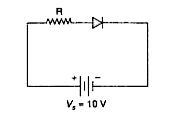A silicon diode requires a minimum current 2 mA to be above the knee point (0.7V) of its V-I characteristics. Assume that the voltage across the diode is independent of current above the knee point.

Find the maximum value of R so that voltage across the diode is above the knee point
2.25kΩ
4.65kΩ
6.25kΩ
2.65kΩ
The correct Answer is:B

Imin=2mA, Vp=Vknee=0.7V, Taking Vs=10V
Applying KVL,10=Imin.Rmax+Vp=2mA.Rmax+Vp
2mA.Rmax=10−Vp=10−0.7=9.3V
∴Rmax=9.3V2×10−3A=9.3×1032=4.65×103Ω ∴Rmax=4.65kΩ
Similar Questions
Assume that the silicon diode in the given circuit requires a minimum current of 1 mA to be above the (knee-point voltage = 0.7 V) of its I−V characteristics. Assuming that the voltage across the diode is independent of current above the knee-point, find the maximum value of R so that the voltage is above the knee-point if VB=5A. Also find the value of R to establish a current of 5 mA in the circuit for the since voltage.

View SolutionAssume that the silicon diode in the circui shown in fig. requires a minimum current of 1mA to be above the knee point (0.7V) of its I−V characteristics. Aslo assume that the voltage across the diode is independent of current above the knee point.
(a) If VB=5V, what should be the maximum value of R so that the voltage is above the knee point?
(b) If VB=5V, what should be the value of R to estabilish the current of 5mA in the circuit?
(c) What is the power dissipated in the resistance R and in the diode, when a current of 5mA flows in the circuit at VB=6V?
(d) If R=1kΩ, what is the minimum voltage VB required to keep the diode above the knee point?
View Solution
Knowledge Check
The junction diode in the following circuit requires a minimum current of 1mA to be above the knee point (0.7V) of its I−V characterstic curve. The voltage across the diode is independent of current above the knee point. If VB=5V, then the maximum value of R so that the voltage is above the knee point, will be
 A4.3kΩB860kΩC4.3ΩD860Ω
A4.3kΩB860kΩC4.3ΩD860Ω
The junction diode in the following circuit requires a minimum current of 1mA to be above the knee point (0.7V) of its I−V characterstic curve. The voltage across the diode is independent of current above the knee point. If VB=5V, then the maximum value of R so that the voltage is above the knee point, will be

View SolutionThe junction diode in the following circuit requires a minimum current of 1mA to be above the knee point (0.7V) of its I−V characterstic curve. The voltage across the diode is independent of current above the knee point. If VB=5V, then the maximum value of R so that the voltage is above the knee point, will be

View SolutionIn the given circuit, the voltage across the load is maintained at 12 V. The current in the zener diode varies from 0.51 mA. What is the maximum wattage of the diode?

View SolutionIn the current versus voltage characteristics of a diode minimum current of 1 mA is required for the knee voltage to be is connected in a cirucit the minimum value of R so that the voltage is above knee point is

View SolutionThe silicon diode shown in fig. is rated for a maximum current of 10mA. Calculate the minimum value of resistor R . Asume the forward voltage drop across the diode to be 0.7V.

View SolutionIn the given circuit the voltage drop across the diode is 0.8 V, if the diode can withstand current upto maximum of 30 mA, then find the maximum voltage of the battery

View SolutionIn the given circuit the voltage drop across the diode is 0.8 V, if the diode can withstand current upto maximum of 30 mA, then find the maximum voltage of the battery

View Solution
